The Cowardly General's Excellent Rifle

Colt 1855 percussion revolving rifle. For use by snipers, it was equipped with an optical sight mounted above the barrel. Photo of the National Museum stories USA, Washington
"Duel". A. I. Kuprin
People and weapon. The progress of military affairs in the middle of the 19th century was so rapid that the military could barely keep up with the designers who were offering more and more new and advanced models of rifles. One of them, which, one might say, made an entire era in the history of arms making in Russia, was the rifle of the American gunsmith Hiram Berdan.
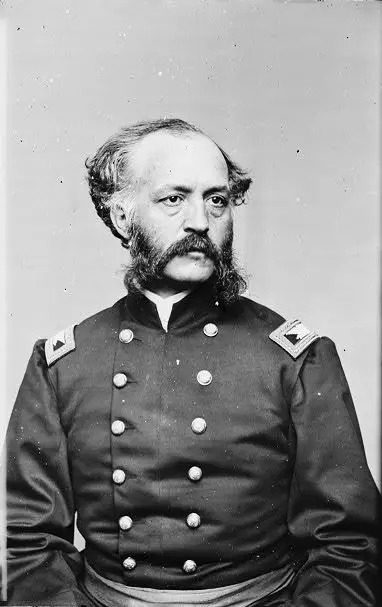
Hiram Berdan (1824–1893). Library of Congress
Berdan was born in 1824 into a family of immigrants from Holland who lived in New York State. His father, John Berdan, was a successful landowner and gave Hiram the opportunity to study as a mechanical engineer at college after school, although he never received a diploma. From childhood he loved hunting and was an excellent shooter, and in 1861 he became the champion of the Northern States of America in shooting. And after graduating from college, he showed a penchant for invention. Moreover, he received his first patent for... a separator back in 1847, after which he began producing agricultural machinery. In 1853, a new invention followed - a gold mining machine, which brought him a handsome profit. Moreover, he even founded a gold mining company.
When the Civil War began in the United States in 1861, Berdan joined the northern army as a volunteer, and not only did he join, but being an excellent shooter, he decided to create a sniper unit in the army and wrote an appeal to the governors of the northern states, inviting the best shooters to join sniper companies. In June 1861, he organized an entire regiment of snipers, led it himself and organized combat training, dressing all his soldiers in dark green uniforms, while all other northerners fought in dark blue.
The selection for Berdan's unit was extremely tough. During the tests, volunteers had to fire 10 shots from a rifle with a conventional scope from a distance of 200 yards (182 m) and place all the bullets exactly in the bull's eye of a target with a diameter of no more than 5 inches (127 mm). Those who “smeared” were rejected without any pity.
The practical Berdan armed his snipers with Colt revolver rifles equipped with telescopic sights as long as the barrel on which they were mounted. These rifles had a high rate of fire, but could be dangerous for a careless owner who, in the heat of battle, forgot to coat the chambers of the drum with “cannon fat”, which is why, when fired, all the charges in the drum ignited simultaneously (“chain fire”), which destroyed the rifle and the left hand of the shooters was crippled.
It is interesting that Hiram Berdan himself was not particularly brave in battles and in every possible way avoided direct participation in battles and, having given the appropriate orders, immediately left the battlefield. Because of this, he was even court-martialed twice, which is why he even had to resign.
However, even without his direct leadership, Berdanov’s riflemen were highly effective in battle and inflicted serious damage on the enemy. As a result, the successes of his regiment, and then of Berdan’s brigade (who, despite outright cowardice, eventually received the rank of general, which was greatly facilitated by his connections “at the top” and excellent organizational skills) gave rise to the formation of ten more similar regiments, whose soldiers wore their green uniforms with pride. In the federal forces, sniper units were usually in the command reserve or represented separate units within the corps. This made it possible to use them at critical moments of the battle, in breakthrough areas to suppress fire or repel a successfully advancing enemy.

An 1859 Sharps rifle with a sniper scope, adopted by Berdan snipers in 1862. Photo of the Horse Soldier auction company
By the way, Berdan himself, having weighed all the pros and cons, already in May 1862 re-equipped his shooters with Sharps rifles, which were loaded from the breech with paper cartridges and had a fairly high rate of fire. By the way, back in the 1880s, American military historians claimed that Berdan's snipers killed more Confederate soldiers than any other unit in the Northern army.
In 1862, Berdan was wounded and left command, and after recovery he began recruiting new snipers, visited a number of weapons production plants and again began working on creating a rifle of his own design. Already in September 1864, Berdan offered the Colt company a rifle of his design, but did not receive a positive response and then again organized his own company to produce it. And his labors were not in vain: the rifle was accepted in Spain to convert old muzzle-loading rifles into breech-loading rifles of 15,24 mm caliber.

Berdan Rifle No. 1 Photo by Rock Island Auction Company
In 1865, Berdan designed a bolt action and his own cartridge for the 10,67 mm caliber. And then it turned out that in America at that time there were representatives of the Artillery Committee of the Main Artillery Directorate of Russia, Colonel A.P. Gorlov and Captain K.I. Gunius. Having examined over a hundred different types of weapons chambered for a cartridge with a metal sleeve, they settled on the Berdan rifle. And our military representatives liked it so much that they offered to order 30 thousand Berdan rifles and 7,5 million cartridges for them at once for Russia, and also took an active part in its refinement, which is why in America this sample was even called “Russian” rifle."
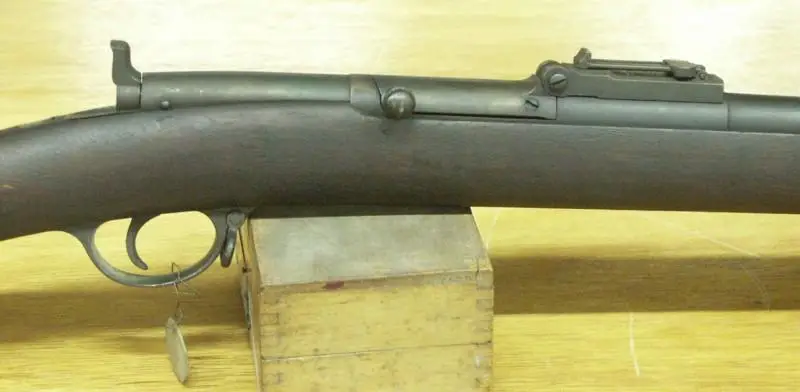
Berdan Rifle Bolt No. 1. Photo by Allen Dobress
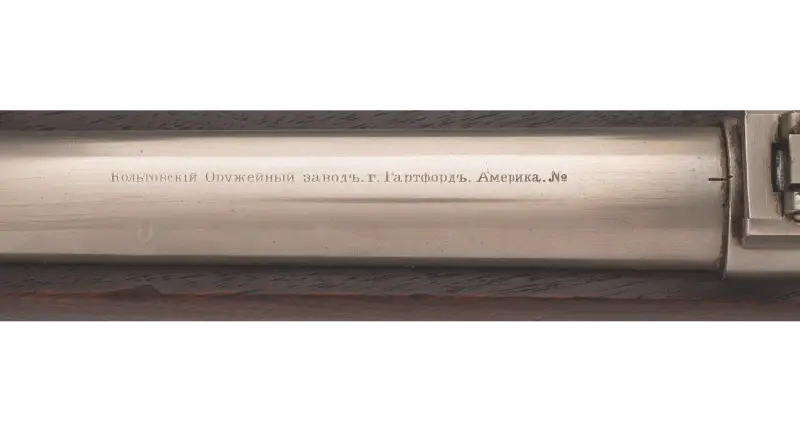
The inscription on the barrel of Berdan rifles No. 1, supplied to Russia from the USA. Photography by Allen Dobress
Then Captain Gunius took samples of the rifle and cartridge to Russia, and Colonel Gorlov had to remain in America to organize work at American military factories. As a result, in 1865 it was finally decided to adopt it into service with the Russian Imperial Army under the name “4,2-line rifle mod. 1868 Berdan system No. 1.” Although it had a folding bolt that had already become familiar at that time, tilting forward along the barrel, its feature was the absence of a traditional trigger that struck the firing pin. Instead, a longitudinally sliding firing pin entered the rear part of the bolt, located in the rear of the receiver and acted by the force of a spiral spring. That is, to load this rifle it was necessary to first push the firing pin back by the handle, then tilt the bolt forward and only then insert the cartridge into the chamber. Having closed the shutter, it was possible to press the trigger, which released the firing pin, which not only broke the cartridge primer, but also additionally locked the shutter itself. The sight was calibrated for a distance from 200 to 1500 steps, and a triangular bayonet was attached to a barrel with six grooves (from the bottom of the barrel). The maximum rate of fire of the rifle reached 18 rounds per minute.
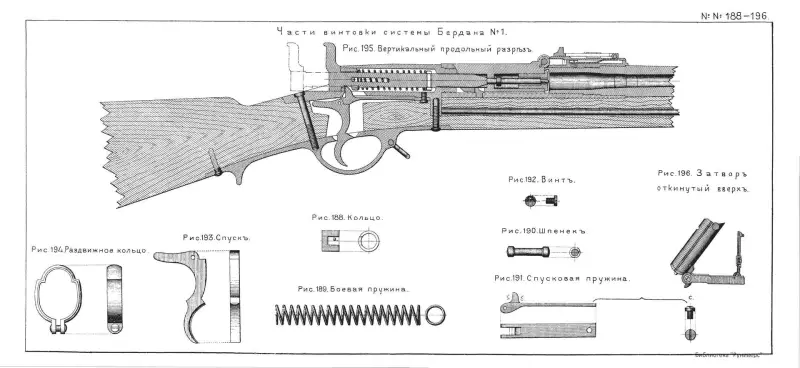
Schematic diagram of the Berdan rifle No. 1 and its details. Drawing from V. G. Fedorov’s album. Atlas of drawings for “Armament of the Russian Army in the XNUMXth Century”
Such an initiative was of very great importance, since it was at this time that the Russian army was in a state of rearmament and was switching to new types of rifles, and it was necessary not to make a mistake in choosing a suitable system in order to quickly provide the army with a reliable, modern and at the same time relatively cheap weapons. So, in November 1866, the rifle of the Englishman Terry, modified by gunsmith I.G. Norman in Tula, was adopted for service. The rifle was a percussion rifle and fired a traditional paper cartridge, which did not make it a modern weapon, but it was advantageous in that it was relatively easy to convert old percussion rifles that were loaded from the muzzle into it. Moreover, it had a sliding bolt and a rate of fire of 5-6 rounds per minute.
In the same year, another Englishman, Karle, proposed a needle rifle for arming the Russian army, in which the primer was located in a wooden circle at the bottom of the cartridge case. It fired up to 10 rounds per minute and was put into service in 1867 in two versions: infantry and small arms. The first sight allowed shooting at only 427 m, and the second - at 853 m, which clearly indicated that the Russian military of that time underestimated long-range shooting. Converting muzzle-loading rifles into needle rifles was not cheap, so only 215 units were produced and were actively used during the Russian-Turkish War of 500-1877.
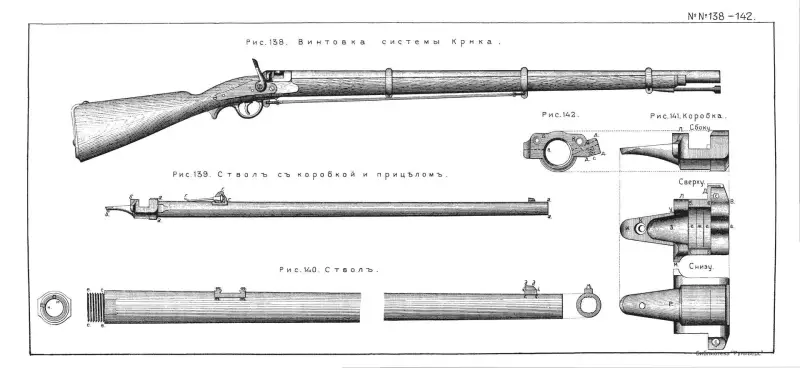
Krnka rifle. Drawing from V. G. Fedorov’s album. Atlas of drawings for “Armament of the Russian Army in the 19th Century”
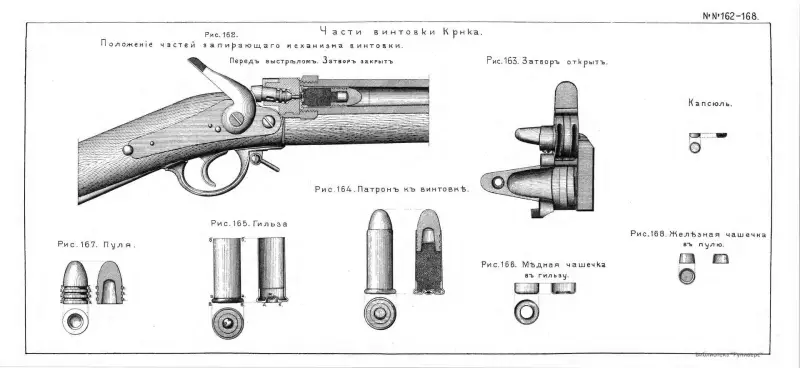
Bolt and cartridge for the Krnka rifle. Drawing from V. G. Fedorov’s album. Atlas of drawings for “Armament of the Russian Army in the 19th Century”
In 1869, the Russian army immediately received two conversion rifles with metal cartridges: N. M. Baranova (very similar in design to the Albini-Brandlin rifle) and the Czech Sylvester Krnka of 15,24 mm caliber, into which the 1856 rifles were converted ., as well as Terry-Norman rifles 1866 and Karl 1868. Baranov rifles went to the navy, and Krnka, nicknamed “krynki” in our country, went to the ground army. Both rifles had hinged bolts, but Baranov’s opened to the front, while Krnk’s opened to the left. Few of the first were produced, only 9872, but the Krnka rifles were produced in 855, which was very good on the eve of the impending war. It was then that the very accurate Berdan No. 500 rifles arrived just in time, turning out to be the most advanced among this entire arsenal.
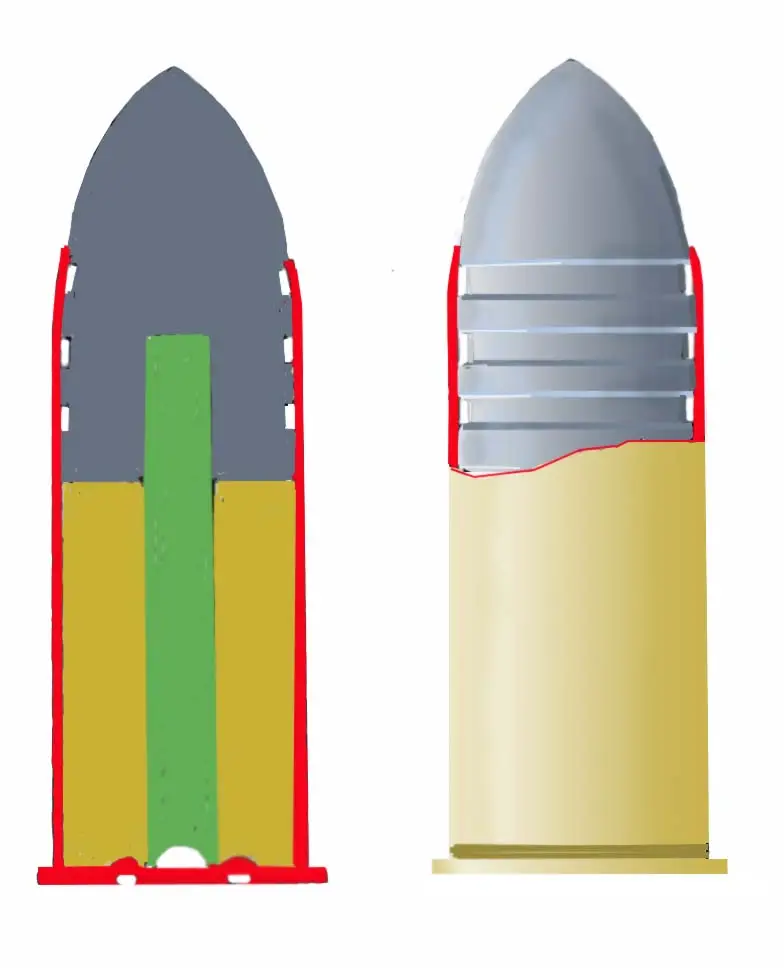
Berdan cartridge according to the 1866 patent. Drawing by A. Sheps
It was also important that in addition to the rifle, Berdan also designed a cartridge for it, which, as it turned out, turned out to be very successful. First of all, the find was a seamless sleeve made of brass, inside of which a brass cup was again inserted to strengthen the bottom part. Before him, sleeves were made from red copper and its alloys, but brass gave less residual deformation. A charge of carbon nitrate powder weighing 5 g provided the bullet with an initial speed of 440 m/s. The bullet, a solid lead weighing 24 g, was wrapped in thin linen paper, twisted at the base. Such a bullet wrap, by the way, proposed by Gorlov and Gunius, protected the bore from leading and improved the fastening of the bullet in the cartridge case. The wrapper was two-colored - white and pink paper. This is how cartridges for a rifle and a carbine differed. The latter had a smaller powder charge. The fully loaded cartridge weighed 40 g.
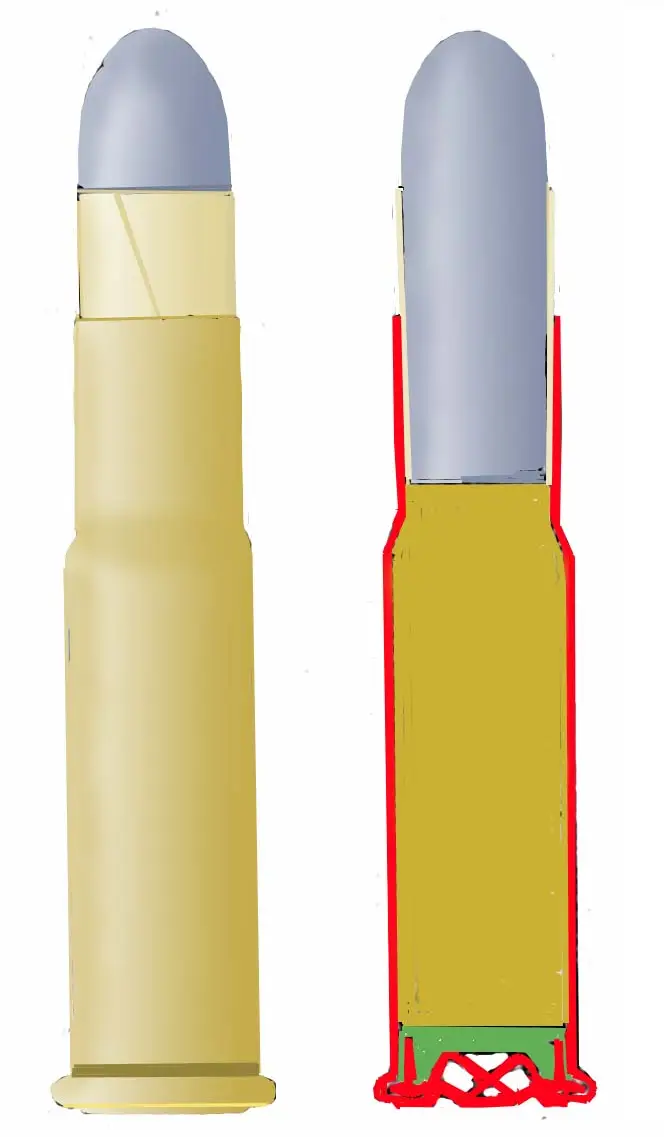
Berdan cartridge according to the 1868 patent. Drawing by A. Sheps
As “Weapons Collection” No. 1 for 1877 wrote,
In terms of ballistic characteristics, the Berdan cartridge, improved by Gorlov and Gunius, was one of the best cartridges with a metal sleeve of that time.
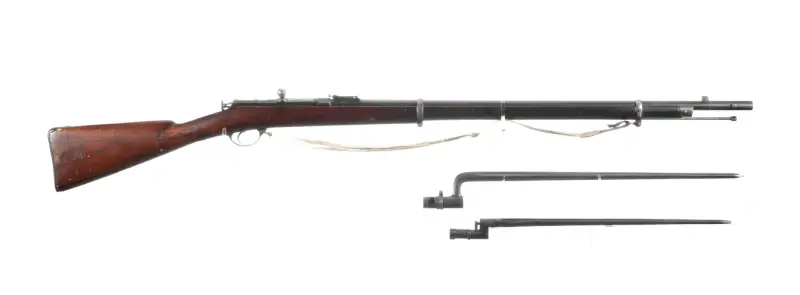
Berdan rifle No. 2 with two types of bayonets: the old triangular Russian army and the new tetrahedral one. Photo by Rock Island Auction Company
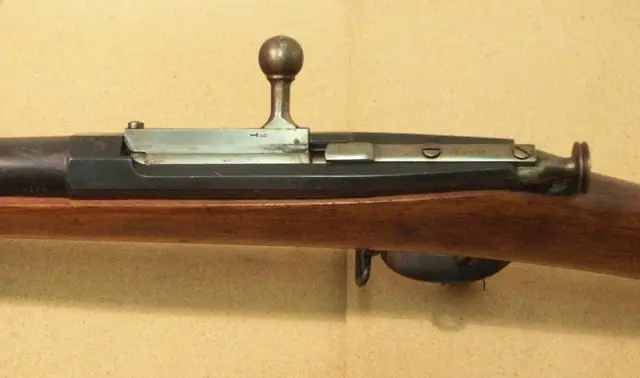
Berdan Rifle Bolt No. 2. Photo by Allen Dobress
But then Berdan himself became interested in the prospects of cooperation with the Russian army and in the spring of 1870 he went to Russia to offer his latest development - a rifle with a rotary sliding bolt. It was simpler in design than the folding one, cheaper to manufacture and provided better extraction of spent cartridges. Now the shooter did not need to remove the empty cartridge case from the chamber - it flew out of it on its own, which made it possible to increase the rate of fire of the new rifle to 28 rounds per minute - an excellent indicator for that time! As a result, this Hiram Berdan rifle was adopted by the Russian Imperial Army, called “Berdan No. 2”. On its basis, a cavalry carbine, dragoon and Cossack rifles were developed, differing only in their length: carbine - 965 mm, dragoon rifle - 1237 mm, Cossack rifle - 1237 mm, and infantry rifle - 1355 mm. Initially, Berdan No. 2 rifles were manufactured in England at a factory in Birmingham.
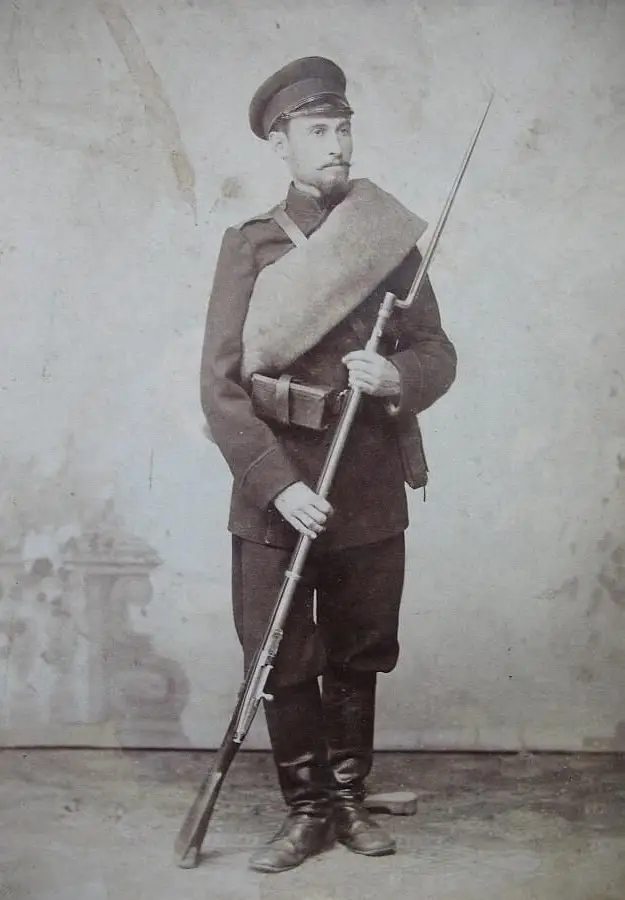
Russian Imperial Army soldier with Berdan rifle No. 2. XNUMXth century photograph
However, already in 1873, their production was established at the Tula and Izhevsk arms factories, where they were produced until 1891, and the appearance of a more advanced and faster-firing repeating rifle by Captain Mosin. Berdan rifles received well-deserved recognition, received the affectionate name “Berdank” among the troops and were used to a limited extent even during the First World War, and subsequently, after drilling out the barrels, they were sold to hunters.
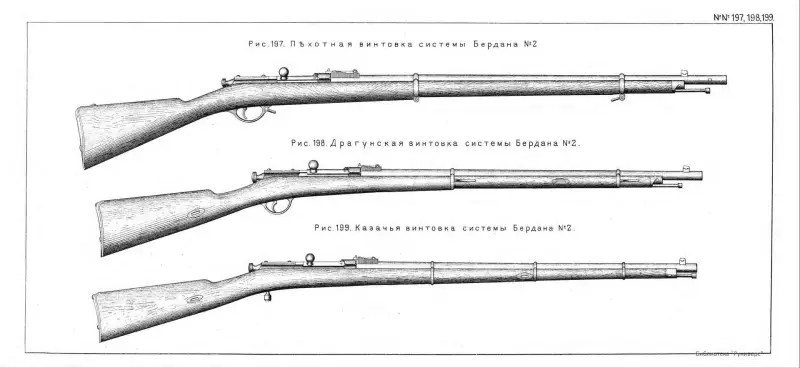
Berdan rifles of the 1870 model, adopted by the Russian Imperial Army. Drawing from V. G. Fedorov’s album. Atlas of drawings for “Armament of the Russian Army in the XNUMXth Century”
It is interesting that for some reason Colonel Gorlov at that time was more sympathetic to the Remington rifle with a tap action, but he did not like the Berdan rifle No. 2. And he, apparently, sent a memo to the Minister of War, General Milyutin, in which he asked to take a closer look at the Remington rifle. But Milyutin showed no interest in it and wrote a rather sarcastic note, which said that Russia is not the Papal State or Egypt, and that it is very important for Russia to develop its own production of modern weapons. That is, he assessed the possibilities of its design from the point of view of perspective, which, as we have already written here, was absent in the Remington rifle.
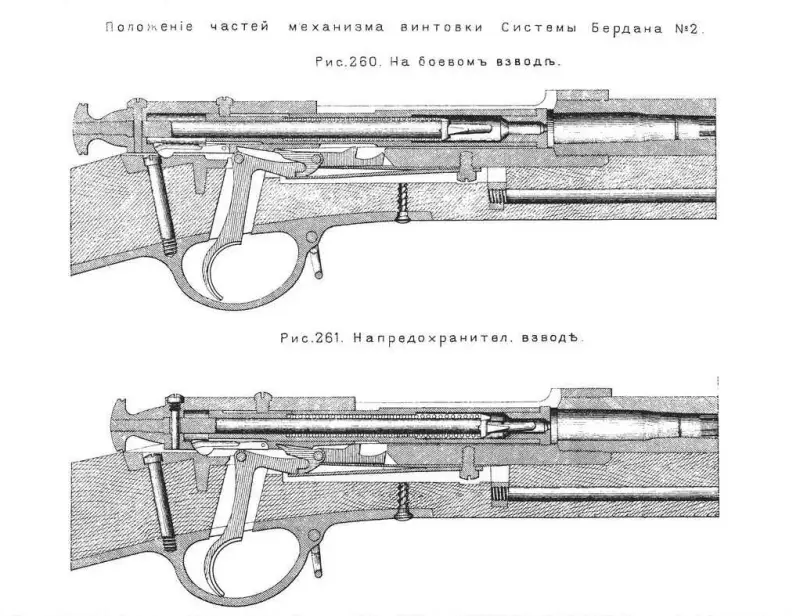
The bolt device of the Berdan rifle No. 2. Drawing from the album of V. G. Fedorov. Atlas of drawings for “Armament of the Russian Army in the XNUMXth Century”
Hiram Berdan died in Washington, surrounded by honor and respect, on March 31, 1893. His not too courageous character did not prevent him from going down in history...
Information